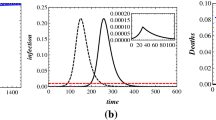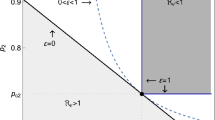Abstract
It is a common medical folk-practice for parents to encourage their children to contract certain infectious diseases while they are young. This folk-practice is controversial, in part, because it contradicts the long-term public health goal of minimizing disease incidence. We study an epidemiological model of infectious disease in an age-structured population where virulence is age-dependent and show that, in some cases, the optimal behavior will increase disease transmission. This provides a rigorous justification of the concept of “endemic stability,” and demonstrates that folk-practices may have been historically justified.
Similar content being viewed by others
References
Anderson, R.M., May, R.M., 1991. Infectious Diseases of Humans: Dynamics and Control. Oxford University Press, New York.
Arrow, K.J., Kurz, M., 1970. Public Investment, the Rate of Return, and Optimal Fiscal Policy. Hopkins Press, Baltimore.
Brommer, J., Kokko, H., Pietiainen, H., 2000. Reproductive effort and reproductive values in periodic environments. Am. Nat. 155, 454–472.
Busenberg, S., van den Driessche, P., 1990. Analysis of a disease transmission model in a population with varying size. J. Math. Biol. 28, 257–280.
Coleman, P.G., Perry, B.D., Woolhouse, M.E.J., 2001. Endemic stability—a veterinary idea applied to human public health. Lancet 357, 1284–1286.
Del Valle, S., Hethcote, H., Hyman, J.M., Castillo-Chavez, C., 2005. Effects of behavioural changes in a smallpox attack model. Math. Biosci. 195, 228–251.
Grundmann, H., Hori, S., Winter, B., Tami, A., Austin, D.J., 2002. Risk factors for the transmission of methicillin-resistant Staphylococcus aureus in an adult intensive care unit: fitting a model to the data. J. Infect. Dis. 185, 481–488.
Hadeler, K.P., 1992. Periodic-solutions of homogeneous equations. J. Differ. Equ. 95, 183–202.
Hadeler, K.P., Waldstatter, R., Worzbusekros, A., 1988. Models for pair formation in bisexual populations. J. Math. Biol. 26, 635–649.
Hofbauer, J., Sigmund, K., 1998. Evolutionary Games and Population Dynamics. Cambridge University Press, Cambridge.
Howard, R.A., 1960. Dynamic Programming and Markov Processes. MIT Press, Cambridge.
Leavitt, J.W., 1997. Typhoid Mary: Captive to the Public’s Health. Beacon Press, Boston.
Mandell, G.L., Bennett, J.E., Dolin, R. (Eds.), 2005. Principles and Practice of Infectious Disease. Elsevier, Philadelphia.
Maynard Smith, J., 1982. Evolution and the Theory of Games, 1st edn. Cambridge University Press, London.
McNamara, J.M., 1997. Optimal life histories for structured populations in fluctuating environments. Theor. Popul. Biol. 51, 94–108.
McNamara, J.M., Houston, A.I., Collins, E.J., 2001. Optimality models in behavioral biology. SIAM Rev. 43, 413–466.
Metz, J.A.J., Nisbet, R.M., Geritz, S.A.H., 1992. How should we define fitness for general ecological scenarios. Trends Ecol. Evol. 7, 198–202.
Morisse, J.P., Le Gall, G., Boilletot, E., 1991. Hepatitis of viral origin in Leporidae: Introduction and aetiological hypotheses. Rev. Sci. Tech. 10, 269–310.
Murray, J.D., 1993. Mathematical Biology, 2nd edn. Springer, New York.
Nathanson, N., Martin, J., 1979. The epidemiology of poliomyelitis: enigmas surrounding its appearance and disappearance. Am. J. Epidemiol. 110, 672.
Pado, F., 2005. Where the play dates are fun, but itchy. New York Times, August 21.
Panagiotopoulos, T., Antoniadou, I., Valassi-Adam, E., 1999. Increase in congenital rubella occurrence after immunisation in Greece: retrospective survey and systematic review. Br. Med. J. 319, 1462–1466.
Parashar, U.D., Hummelman, E.G., Bresee, J.S., Miller, M.A., Glass, R.I., 2003. Global illness and deaths caused by rotavirus disease in children. Emerg. Infect. Dis. 9, 565–572.
Paul, J.R., 1971. A History of Poliomyelitis. Yale University Press, New Haven.
Preblud, S.R., 1986. Varicella: complications and costs. Pediatrics 79, 728–735.
van Baalen, M., 1998. Coevolution of recovery ability and virulence. Proc. Biol. Sci. 265, 317–325.
van den Driessche, P., Watmough, J., 2002. Reproduction numbers and sub-threshold endemic equilibria for compartmental models of disease transmission. Math. Biosci. 180, 29–48.
Weinstein, L., Shelokov, A., Seltser, R., Winchell, G.D., 1952. A comparison of the clinical features of poliomyelitis in adults and in children. New Engl. J. Med. 246, 297–302.
World Health Organization, 2000. Rubella vaccines. Weekly Epidemiol. Rec. 75, 161–172.
Author information
Authors and Affiliations
Corresponding author
Rights and permissions
About this article
Cite this article
Reluga, T.C., Medlock, J., Poolman, E. et al. Optimal Timing of Disease Transmission in an Age-Structured Population. Bull. Math. Biol. 69, 2711–2722 (2007). https://doi.org/10.1007/s11538-007-9238-5
Received:
Accepted:
Published:
Issue Date:
DOI: https://doi.org/10.1007/s11538-007-9238-5




